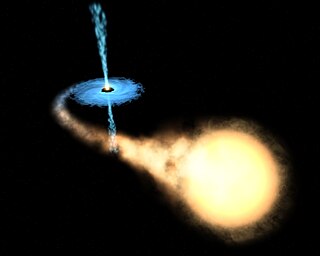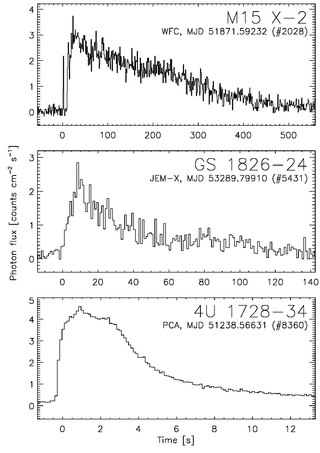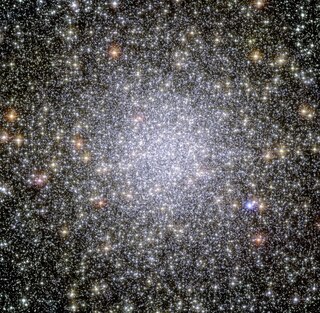Related Research Articles

A neutron star is a collapsed core of a massive supergiant star. Stars that collapse into neutron stars have a total mass of between 10 and 25 solar masses (M☉), or possibly more for those that are especially rich in elements heavier than hydrogen and helium. Except for black holes, neutron stars are the smallest and densest known class of stellar objects. Neutron stars have a radius on the order of 10 kilometers (6 mi) and a mass of about 1.4 M☉. They result from the supernova explosion of a massive star, combined with gravitational collapse, that compresses the core past white dwarf star density to that of atomic nuclei.

Cygnus X-1 (abbreviated Cyg X-1) is a galactic X-ray source in the constellation Cygnus and was the first such source widely accepted to be a black hole. It was discovered in 1965 during a rocket flight and is one of the strongest X-ray sources detectable from Earth, producing a peak X-ray flux density of 2.3×10−23 W/(m2⋅Hz) (2.3×103 jansky). It remains among the most studied astronomical objects in its class. The compact object is now estimated to have a mass about 21.2 times the mass of the Sun and has been shown to be too small to be any known kind of normal star or other likely object besides a black hole. If so, the radius of its event horizon has 300 km "as upper bound to the linear dimension of the source region" of occasional X-ray bursts lasting only for about 1 ms.

Norma is a small constellation in the Southern Celestial Hemisphere between Ara and Lupus, one of twelve drawn up in the 18th century by French astronomer Nicolas-Louis de Lacaille and one of several depicting scientific instruments. Its name is Latin for normal, referring to a right angle, and is variously considered to represent a rule, a carpenter's square, a set square or a level. It remains one of the 88 modern constellations.

X-ray binaries are a class of binary stars that are luminous in X-rays. The X-rays are produced by matter falling from one component, called the donor, to the other component, called the accretor, which is either a neutron star or black hole. The infalling matter releases gravitational potential energy, up to 30 percent of its rest mass, as X-rays. The lifetime and the mass-transfer rate in an X-ray binary depends on the evolutionary status of the donor star, the mass ratio between the stellar components, and their orbital separation.

X-ray bursters are one class of X-ray binary stars exhibiting X-ray bursts, periodic and rapid increases in luminosity that peak in the X-ray region of the electromagnetic spectrum. These astrophysical systems are composed of an accreting neutron star and a main sequence companion 'donor' star. There are two types of X-ray bursts, designated I and II. Type I bursts are caused by thermonuclear runaway, while type II arise from the release of gravitational (potential) energy liberated through accretion. For type I (thermonuclear) bursts, the mass transferred from the donor star accumulates on the surface of the neutron star until it ignites and fuses in a burst, producing X-rays. The behaviour of X-ray bursters is similar to the behaviour of recurrent novae. In the latter case the compact object is a white dwarf that accretes hydrogen that finally undergoes explosive burning.

An intermediate-mass black hole (IMBH) is a class of black hole with mass in the range 102–105 solar masses: significantly higher than stellar black holes but lower than the 105–109 solar mass supermassive black holes. Several IMBH candidate objects have been discovered in the Milky Way galaxy and others nearby, based on indirect gas cloud velocity and accretion disk spectra observations of various evidentiary strength.

A stellar black hole is a black hole formed by the gravitational collapse of a star. They have masses ranging from about 5 to several tens of solar masses. They are the remnants of supernova explosions, which may be observed as a type of gamma ray burst. These black holes are also referred to as collapsars.
X-ray pulsars or accretion-powered pulsars are a class of astronomical objects that are X-ray sources displaying strict periodic variations in X-ray intensity. The X-ray periods range from as little as a fraction of a second to as much as several minutes.

47 Tucanae or 47 Tuc is a globular cluster located in the constellation Tucana. It is about 4.45 ± 0.01 kpc (15,000 ± 33 ly) from Earth, and 120 light years in diameter. 47 Tuc can be seen with the naked eye, with an apparent magnitude of 4.1. It appears about 44 arcminutes across including its far outreaches. Due to its far southern location, 18° from the south celestial pole, it was not catalogued by European astronomers until the 1750s, when the cluster was first identified by Nicolas-Louis de Lacaille from South Africa.

Centaurus X-3 is an X-ray pulsar with a period of 4.84 seconds. It was the first X-ray pulsar to be discovered, and the third X-ray source to be discovered in the constellation Centaurus. The system consists of a neutron star orbiting a massive, O-type supergiant star dubbed Krzemiński's star after its discoverer, Wojciech Krzemiński. Matter is being accreted from the star onto the neutron star, resulting in X-ray emission.
The Tolman–Oppenheimer–Volkoff limit is an upper bound to the mass of cold, non-rotating neutron stars, analogous to the Chandrasekhar limit for white dwarf stars. Stars more massive than the TOV limit collapse into a black hole. The original calculation in 1939, which neglected complications such as nuclear forces between neutrons, placed this limit at approximately 0.7 solar masses (M☉). Later, more refined analyses have resulted in larger values.

An ultraluminous X-ray source (ULX) is an astronomical source of X-rays that is less luminous than an active galactic nucleus but is more consistently luminous than any known stellar process (over 1039 erg/s, or 1032 watts), assuming that it radiates isotropically (the same in all directions). Typically there is about one ULX per galaxy in galaxies which host them, but some galaxies contain many. The Milky Way has not been shown to contain a ULX, although SS 433 may be a possible source. The main interest in ULXs stems from their luminosity exceeding the Eddington luminosity of neutron stars and even stellar black holes. It is not known what powers ULXs; models include beamed emission of stellar mass objects, accreting intermediate-mass black holes, and super-Eddington emission.

Stellar mass loss is a phenomenon observed in stars by which stars lose some mass over their lives. Mass loss can be caused by triggering events that cause the sudden ejection of a large portion of the star's mass. It can also occur when a star gradually loses material to a binary companion or due to strong stellar winds. Massive stars are particularly susceptible to losing mass in the later stages of evolution. The amount and rate of mass loss varies widely based on numerous factors.

Vela X-1 is a pulsing, eclipsing high-mass X-ray binary (HMXB) system, associated with the Uhuru source 4U 0900-40 and the supergiant star HD 77581. The X-ray emission of the neutron star is caused by the capture and accretion of matter from the stellar wind of the supergiant companion. Vela X-1 is the prototypical detached HMXB.

Astrophysical X-ray sources are astronomical objects with physical properties which result in the emission of X-rays.
QX Normae is an active low mass X ray binary in the constellation Norma. It is composed of a neutron star and a star smaller and cooler than the Sun. The X-ray component, known as 4U 1608–52, was discovered in the early 1970s, while the visual component, QX Normae, was discovered in 1977. By analysing the interstellar extinction between Earth and the system, Güver and colleagues calculated the most likely distance to be 5.8 kpc, and the neutron star's mass to be 1.74 ± 0.14 times that of the Sun and radius to be a mere 9.3 ± 1.0 km.
3XMM J004232.1+411314 is a low-mass X-ray binary hosted in the galaxy M31. It is the most luminous source of hard X-rays in the Andromeda Galaxy. It is also the most luminous source known that shows dips in the X-ray light curve. The compact object in this system has been unambiguously identified as a neutron star with a spin period of 3 seconds.

UY Volantis, also known as EXO 0748-676, is a low mass X-ray binary system located in the constellation Volans. With an apparent magnitude of 16.9, it requires a powerful telescope to see. With a radial velocity of 20 km/s, it is drifting away from the Solar System, and is currently located 26,000 light years away.
OAO 1657-415 is a high-mass X-ray binary (HMXB) located in the constellation of Scorpius, over 20,000 light years away. It is believed to be composed of a compact object and a highly evolved massive slash star, with Wolf–Rayet and O-type features in its spectrum, with a spectral type of Ofpe/WN9. OAO 1657-415 is special as it has the largest eccentricity and orbital period of any HMXB, and also because its donor star is much more evolved than many other HMXB donor stars.
References
- 1 2 "V* QV Normae". SIMBAD . Centre de données astronomiques de Strasbourg . Retrieved 20 May 2015.
- 1 2 3 Otero, Sebastian Alberto (23 May 2011). "V QV Nor". The International Variable Star Index. Retrieved 20 May 2015.
- 1 2 Hemphill, Paul B.; Rothschild, Richard E.; Markowitz, Alex; Fürst, Felix; Pottschmidt, Katja; Wilms, Jörn (2014). "A Clumpy Stellar Wind and Luminosity-dependent Cyclotron Line Revealed by the First Suzaku Observation of the High-mass X-Ray Binary 4U 1538-522". The Astrophysical Journal. 792 (1): 15. arXiv: 1407.1028 . Bibcode:2014ApJ...792...14H. doi:10.1088/0004-637X/792/1/14. S2CID 28693293.
- ↑ Reynolds, A. P.; Bell, S. A.; Hilditch, R. W. (1992). "Optical spectroscopy of the massive X-ray binary QV Nor (4U 1538 - 52)". Monthly Notices of the Royal Astronomical Society. 256 (4): 631–40. Bibcode:1992MNRAS.256..631R. doi: 10.1093/mnras/256.4.631 . ISSN 0035-8711.